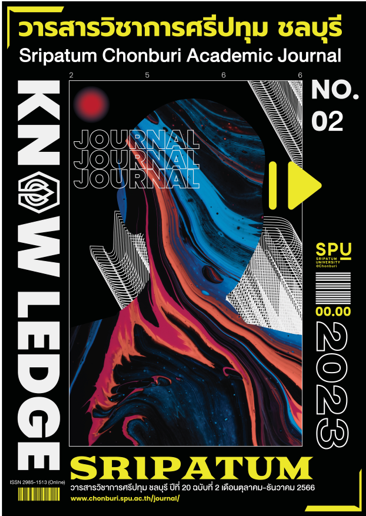A PRODUCTION OF EDUTAINMENT MEDIA FOR UNLIMITED LEARNING IN THE LIVING LIBRARY
Keywords:
Infotainment, Play and Learn, Living LibraryAbstract
The objective of this research was to 1) produce an Edutainment media format to enhance informal learning, 2) study the academic achievement of students studying with live libraries, and 3) investigate the students’ satisfaction before and after learning from the Edutainment media. The forms of edutainment media were obtained from the analysis of Thai and international research papers. The model was assessed and certified by experts. The samples acquired by purposive random sampling were eight 3rd grade early childhood and twelve 6th grade students enrolled in Semester 2/2022. The research equipment included edutainment media and achievement test. The analysis tools were percentage, average, standard deviation, item difficulty (p) and discrimination index (r) and Paired-Samples t test. The results showed that: 1) the form of edutainment consisted of a pop-up slide cards making use of Thai language’s eight final consonant sound prototypes: /-ng/, /-p/, /-n/, /-m/, /-k/, /-t/, /-oe/, and /-oei/, 2) the effectiveness index of the produced edutainment had a performance index at 0.58, and 3) the students learning achievement of posttest scores was higher than the pretest at 0.01 levels. And the students’ satisfaction was found at a high level, with an average of 4.29.
References
กรมกิจการเด็กและเยาวชน. (2563). รายงานการสำรวจความคิดของเด็กและเยาวชนในหัวข้อ “เด็กและเยาวชนคิดและทำอะไรในแต่ละวัน” (ออนไลน์).
เข้าถึงได้จาก: https://www.dcy.go.th/public/mainWeb/file_download/1653283114029-672024637.pdf [2565, 17 ตุลาคม].
จุฑาทิพย์ อรุณรัตน์ และเทียมยศ ปะสาวะโน. (2562). การผลิตสื่อวีดิทัศน์ออนไลน์โดยการเรียนรู้แบบหรรษา รายวิชาดนตรี-นาฏศิลป์ สำหรับนักเรียนชั้นประถม
ศึกษาปีที่ 3. วารสารมหาจุฬาวิชาการ, 7(1), หน้า 17-23.
ชลิตา สุนันทาภรณ์. (2561). เรียนปนเล่นเล่นปนเรียน:กระบวนการเรียนรู้ที่เหมาะสมสำหรับเด็กปฐมวัย (ออนไลน์). เข้าถึงได้จาก:
https://thepotential.org/knowledge/play-based-learning [2564, 24 กรกฎาคม].
เทศบาลตำบลกุดนกเปล้า. (2565). ข้อมูลพื้นฐาน (ออนไลน์). เข้าถึงได้จาก: https://www.kudnokplao.go.th/contact.php [2565, 15 กันยายน].
ธัญชนก กังนิกร, ปิยวดี มากพา และกิตติกรณ์ นพอุดมพันธุ์. (2564). การจัดการเรียนรู้ตามอัธยาศัยสำหรับเด็กและเยาวชนด้วยกระบวนการมีส่วนร่วมเพื่อส่งเสริม
ความตระหนักรู้คุณค่าในการแสดงหนังใหญ่ วัดสว่างอารมณ์ จังหวัดสิงห์บุรี. วารสารชุมชนวิจัย, 15(4), หน้า 260-270.
พิมพ์พร ครอบครอง. (2559). ผลการใช้วิธีการสอนแบบเรียนปนเล่น กลุ่มสาระการเรียนรู้คณิตศาสตร์เรื่อง การบวกและการลบจำนวน สำหรับนักเรียนชั้นประถม
ศึกษาปีที่ 1. วิทยานิพนธ์การศึกษามหาบัณฑิต สาขาวิชาหลักสูตรและการสอน, คณะศึกษาศาสตร์ มหาวิทยาลัยบูรพา.
โรงเรียนวัดกุดนกเปล้า. (2565). ข้อมูลและสภาพทั่วไปของโรงเรียนวัดกุดนกเปล้า (ออนไลน์). เข้าถึงได้จาก:
https://www.kudnokplao.go.th/detailRev2.php?page=4&id=318 [2564, 24 กรกฎาคม].
ล้วน สายยศ และอังคณา สายยศ. (2549). เทคนิคการวิจัยทางการศึกษา (พิมพ์ครั้งที่ 3). กรุงเทพฯ: สุวีริยาสาส์น.
Downloads
Published
Issue
Section
License
Copyright (c) 2023 Sripatum Chonburi Academic Journal

This work is licensed under a Creative Commons Attribution-NonCommercial-NoDerivatives 4.0 International License.
บทความทุกบทความเป็นลิขสิทธิ์ของวารสารวิชาการศรีปทุม ชลบุรี



